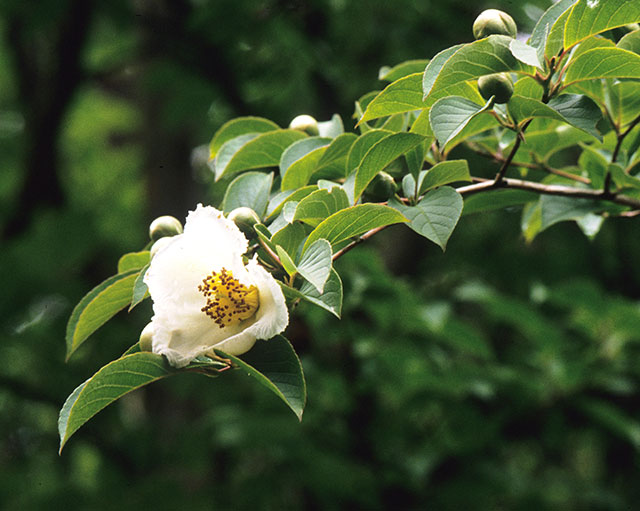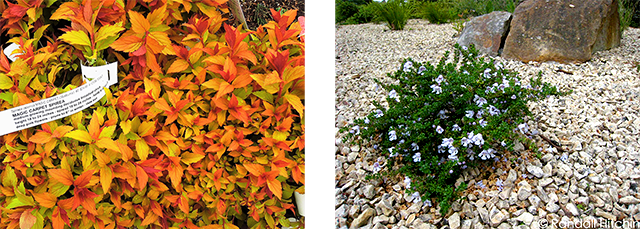Splendid Plants for Small Gardens

 By Janine Anderson, CPH
By Janine Anderson, CPH
Professional Member, APLD
Few of us have sprawling estates where we can lie beneath the canopies of
towering oaks and majestic pines. We need to visit a park or arboretum to
do that. For most of us, our patches of ground are significantly more
modest. In urban areas such as Seattle, residential lots can be as small as
2,500 square feet, and cottage developments might have as many as 12 houses
on 6,400 square feet! How can we transform our postage stamp-sized garden
plot into a little piece of paradise?
The Sky’s the Limit
Tall, narrow plants don’t require much real estate but can add a lot of
punch to your garden. Many conifers get quite tall, but remain just a few
feet wide. Among the narrower selections are Italian Cypress-- Cupressus sempervirens ‘Tiny Towers’ is a good choice with its
diminutive scale and striking gray blue foliage. Other forms to consider
include Weeping Sequoia (Sequoiadendron giganteum ‘Pendulum’);
Weeping Alaska Cedar (try Chamaecyparis nootkatensis ‘Van den
Akker’); and Contorted Japanese Larch (Larix kaempferi ‘Diana’).

Sequoiadendron giganteum ‘Pendula’ is a dramatic vertical element that takes very little space in a small garden.
Image courtesy of Janine Anderson
Which Tree?
If you have room for only one tree, selecting it can be agonizing. In
addition to ultimate height, think about form. Generally, a tree for a
small garden should be taller than wide. Japanese Stewartia (Stewartia pseudocamellia) is an exquisite four-season tree that
reaches 25 feet tall but only 6 feet wide after 10 years, and it lends
itself to being “limbed up” (having lower branches removed) if need be.
Many Japanese maples are suitable for small gardens, but again select one
with an upright form as many have a wide-spreading lateral branching
pattern. Some large shrubs, including many species rhododendrons, can be
arborized (trained into a tree form) so that they essentially become
stately small-scale trees. Rhododendron auriculatum is one that
bears fragrant white to light pink flowers in mid to late summer.
Two websites can be helpful in narrowing down the choices. The “Great Plant
Picks” website has trees listed in the category, “Small Spaces—Big Impact!
,” and the City of Seattle Master Tree List
has approved trees listed by size, from large to small. Be careful, though.
Just because a tree is listed as being appropriate for small spaces doesn’t
necessarily mean it will not outgrow your site.

Stewartia pseudocamellia is a relatively narrow deciduous tree with four-season attributes: handsome form, beautiful bark, exquisite fall color, and camellia-like summer flowers.
Image ©Mary Randlett, courtesy Great Plant Picks
Consider Two Dimensions
Some plants are fairly easy to train into a two-dimensional form against a
fence or wall. Branches to the left and right of the main trunk are
retained, while those growing forward or backward are removed or pruned
back. This technique is called espaliering. Edible fruit trees are often
espaliered because more trees can be grown in a given area and flowering
branches will receive more light and grow better fruit.
When trained against a trellis, an ornamental shrub essentially becomes a
fence or screen, and the effect can be lovely, as well as space saving.
Large shrubs can be espaliered in planting beds only a few feet deep, or
they can be espaliered at the backs of larger beds, allowing for a greater
variety of plants in the foreground. Some larger shrubs that lend
themselves to espalier include Witch Hazel (Hamamelis), Autumn
Camellia (Camellia sasanqua), and Strawberry Tree (Arbutus unedo). All of these have attributes that make them
attractive year-round. Witch Hazels have fragrant winter flowers followed
by “corrugated leaves” and stunning fall color. The fragrant white flowers
of Camellia sasanqua ‘Setsugekka’ contrast with its dark, glossy
leaves. The fall fruits of the Strawberry Tree appear together with its
small urn-shaped white flowers, and its peeling cinnamon-colored bark and
leathery evergreen foliage provide interest throughout the year.

Bright green, gently corrugated leaves emerge after the fragrant winter flowers of the Witchhazel Hamamelis x intermedia ‘Jelena’. Usually a large shrub, here it is espaliered against a trellis.
Image courtesy of Janine Anderson
Go Low
Don’t forget the ground plane. Small shrubs compliment larger plants in
your garden by providing contrast. Several heavenly scented daphnes are
appealing when planted in small groups. Among them are the winter-flowering Daphne odora ‘Aureomarginata’, the long-flowering variegated
daphne, Daphne transatlantica ‘Summer Ice’, and the compact
evergreen, Daphne tangutica, whose red fall berries follow summer
flowers. Pieris japonica ‘Cavatine’ is another miniature that has
striking evergreen leaves year-round, as well as large clusters of
urn-shaped flowers in late winter to early spring. A deciduous shrub with
lovely foliage is Spiraea japonica ‘Magic Carpet’. Reaching only
three feet tall, the early spring leaves on Magic Carpet Spirea are
brilliant orange yellow softening to orange-blushed chartreuse as it
evolves. If it begins to look “tired” in the summer, cutting stems back
will encourage a fresh flush of new foliage. A favorite from Australia,
Alpine Bush Mint (Prostanthera cuneata), tops out at under 2 feet
tall, has tiny aromatic evergreen leaves, and thrives on little or no water
once established.

A trio of wonderful low shrubs suitable for a small garden. Top: Fragrant spring and summer flowers of Daphne tangutica are followed by red fruits in the fall.
Images ©Richie Steffen, courtesy Great Plant Picks

Top left: Hues of Spiraea japonica ‘Magic Carpet’ foliage change throughout the growing season. Image courtesy of Janine Anderson
Top right: The small evergreen shrub Prostanthera cuneata is attractive as well practical. Image ©Randall Hitchin
Consider Containment
A planted container is a garden in miniature that can transform a barren
entryway or patio. Plants soften hard elements and provide depth, in
addition to interesting texture, form, color, scent, etc., to an otherwise
static space. The axiom, “thrillers, fillers, and spillers,” is a handy
guide when designing a container planting. Select a focal plant (thriller)
with striking scale or form, such as a large, spiky yucca, surround it with
soft plants such as heuchera, and drape it with lush spillers such as
cascading calibrachoas. Keep in mind that the vessels you choose for your
container display are sculptural elements that should reflect your personal
taste and compliment the style of your home.

Softening a concrete paver patio is the thriller Grevillea, a magnet for hummingbirds, combined with heather and lamb’s ears fillers, while Chinese Plumbago cascades over the side of the pot.
Image courtesy of Janine Anderson
Think Twice
Sadly, some exquisite plants are simply not suitable for small gardens.
Deciding which ones to rule out is somewhat subjective, but here are a few
you might want to think twice about incorporating into your petite plot.
The late spring blue flowers of Ceanothus are seductive, but you
might eventually decide its drawbacks outweigh its attributes. There’s
little to recommend the plant after the flowers fade. Over time, most Ceanothus varieties become supersized, and the blotchy stems that
persist after flowering are hardly ornamental. Other plants you might
consider eliminating from your list include those whose branches arch from
the base, such as Cotoneaster lacteus and Doublefile Viburnum (Viburnum plicatum var tomentosum ‘Mariesii’). You might
similarly pass up large shrubs with rounded forms that don’t lend
themselves to arborizing. Aucuba and Eleagnus fall into
this category.

Think twice before you plant a space-hungry shrub such as Cotoneaster lacteus!
Image ©Patrick Breen, Oregon State University, courtesy Great Plant Picks
Keep in Mind
In a small garden, every plant is critically important as there is no space
to waste. Gardeners are often seduced by a plant’s flowers, but flowers are
fleeting so try to select plants with year-round attributes such as
fragrance, fall color, texture, beautiful bark, or interesting form.
If you find yourself immobilized by uncertainty, consider asking a
landscape professional for help. Landscape designers can help you select
the best plants for your site and assist you in creating a little piece of
paradise in your own backyard—transforming it into a backyard you can’t
wait to come home to!



Sequoiadendron giganteum ‘Pendula’ is a dramatic vertical element that takes very little space in a small garden. Image courtesy of Janine Anderson

Stewartia pseudocamellia is a relatively narrow deciduous tree with four-season attributes: handsome form, beautiful bark, exquisite fall color, and camellia-like summer flowers. Image ©Mary Randlett, courtesy Great Plant Picks

Bright green, gently corrugated leaves emerge after the fragrant winter flowers of the Witchhazel Hamamelis x intermedia ‘Jelena’. Usually a large shrub, here it is espaliered against a trellis. Image courtesy of Janine Anderson

A trio of wonderful low shrubs suitable for a small garden. Top: Fragrant spring and summer flowers of Daphne tangutica are followed by red fruits in the fall.
Images ©Richie Steffen, courtesy Great Plant Picks

Top left: Hues of Spiraea japonica ‘Magic Carpet’ foliage change throughout the growing season. Image courtesy of Janine Anderson
Top right: The small evergreen shrub Prostanthera cuneata is attractive as well practical. Image ©Randall Hitchin

Softening a concrete paver patio is the thriller Grevillea, a magnet for hummingbirds, combined with heather and lamb’s ears fillers, while Chinese Plumbago cascades over the side of the pot. Image courtesy of Janine Anderson

Think twice before you plant a space-hungry shrub such as Cotoneaster lacteus! Image ©Patrick Breen, Oregon State University, courtesy Great Plant Picks
